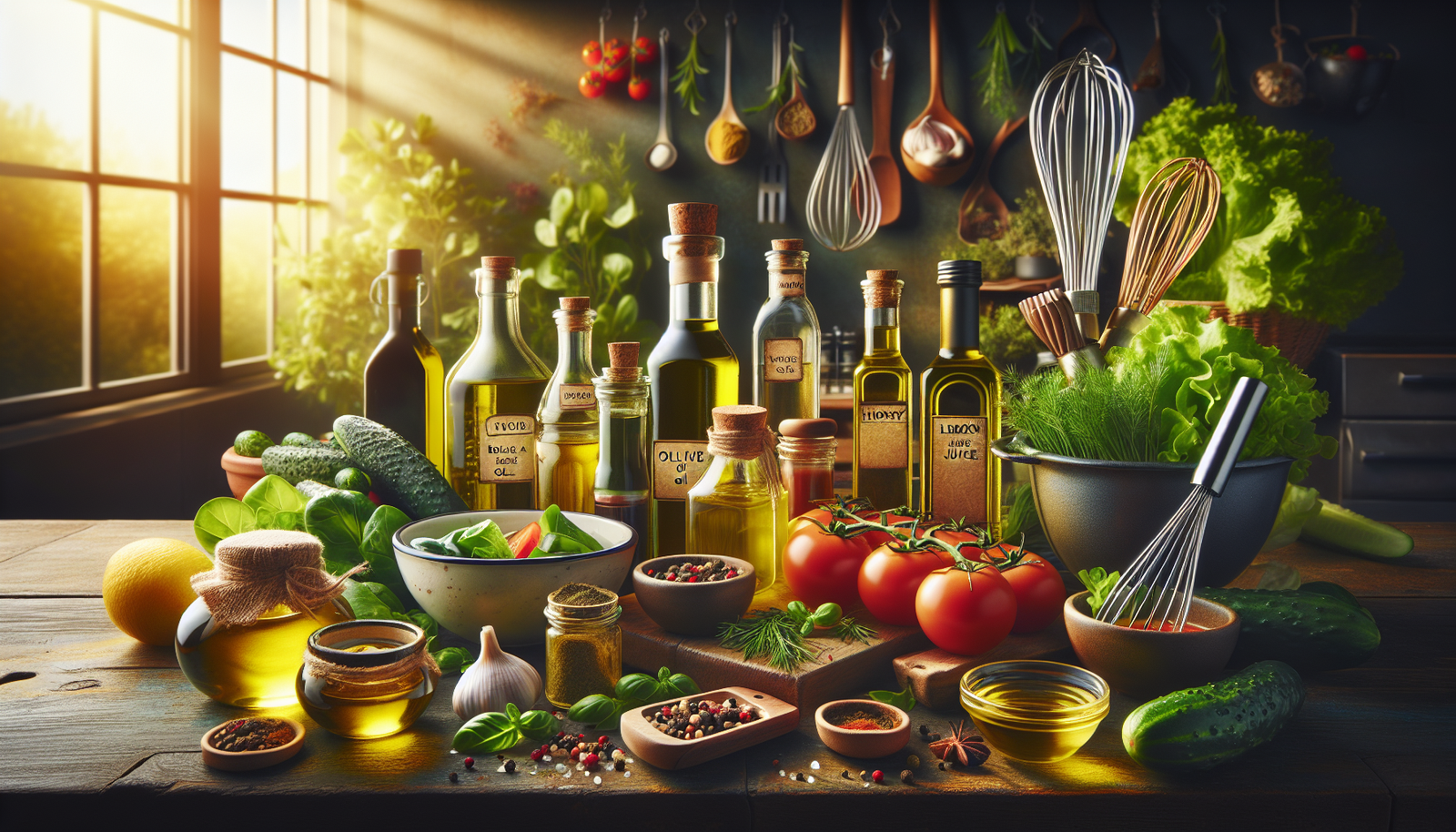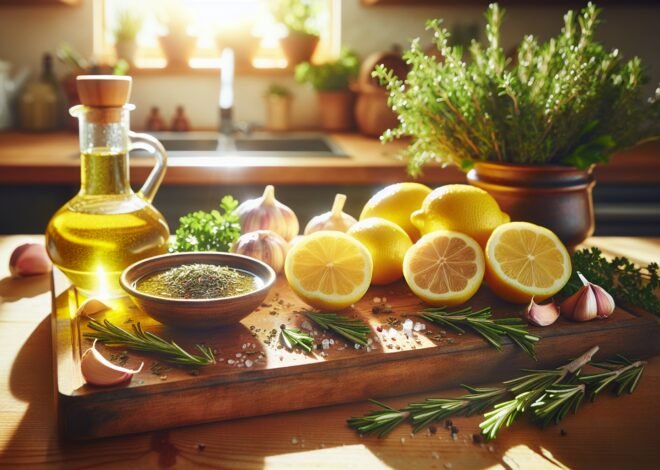
How to Make Homemade Salad Dressings for Extra Flavor
make homemade salad dressings to elevate the taste of your salads instantly. Did you know that store-bought dressings are often filled with preservatives and added sugars? Creating your salad dressings at home not only ensures freshness but also allows you to customize flavors to your preference. This guide will walk you through simple techniques and recipes to make zesty vinaigrettes, creamy dressings, and tangy options using fresh ingredients from your kitchen. Ready to transform your salads from ordinary to extraordinary?
## Benefits of Making Homemade Salad Dressings
Crafting your own salad dressings offers incredible advantages. You gain control over flavors and ingredients, making meals healthier and more delightful. Let’s explore how homemade dressings can transform your salad experience.
### Enhance Flavor with Fresh Ingredients
Fresh ingredients elevate your salad dressings to new heights. Using freshly squeezed lemon juice or minced garlic enhances taste far beyond store-bought options. Fresh herbs like dill, basil, and cilantro add unique flavors that dried alternatives can’t match. The vibrant taste of fresh ingredients not only enhances your salad but also makes each meal exciting.
– **Fresh herbs vs. dried herbs**: Fresh herbs provide a more intense flavor.
– **Citrus zest**: Adds a tangy twist.
– **Garlic and onion**: Offer robust, savory notes.
Creating dressings from fresh produce gives you endless possibilities to experiment. You can customize flavors to suit different types of salads, from leafy greens to hearty grains. The freshness and flavor complexity make homemade dressings a delicious choice, turning a simple salad into a gourmet experience.
### Control Over Ingredients and Nutritional Content
When you make your own dressings, you control every ingredient that goes into them. This means you can avoid unnecessary sugars, unhealthy fats, and preservatives found in many commercial dressings. You can choose organic ingredients, tailor the salt levels, and use natural sweeteners if desired.
– **Healthier oils**: Opt for olive or avocado oil instead of soybean or canola.
– **Natural sweeteners**: Use honey or maple syrup to reduce refined sugars.
– **Allergy-friendly**: Adjust recipes to avoid allergens like nuts or dairy.
This level of control ensures that your dressings align with dietary goals, whether that means reducing calories or increasing healthy fats. It also means your salads can be just as nutritious as they are tasty.
### Cost-Effective and Reduces Waste
Homemade salad dressings are kinder to your wallet and the environment. Store-bought dressings can be expensive, especially premium or organic brands. By making your own, you save money by buying ingredients in bulk, which also reduces packaging waste.
– **Bulk ingredients**: Purchase oils and vinegars in larger quantities.
– **Reuse containers**: Store homemade dressings in reusable jars.
– **Use leftovers**: Incorporate leftover herbs or citrus in your dressings.
Creating your own dressings encourages the use of every ingredient you buy, reducing food waste. This sustainable approach benefits both your budget and the planet, while ensuring that nothing goes to waste.
## Essential Ingredients for Homemade Salad Dressings
Creating the perfect salad dressing starts with selecting the right ingredients. From vinegars to oils, each component plays a crucial role in flavor and health. Here’s how to choose the best ingredients for your homemade concoctions.
### Choosing the Right Vinegars for Dressings
Vinegar is a cornerstone of many dressings, offering acidity and depth. The type of vinegar you choose can dramatically affect the flavor profile.
– **Balsamic vinegar**: Rich and sweet, perfect for robust salads.
– **Apple cider vinegar**: Offers a tangy, fruity flavor ideal for lighter fare.
– **Red wine vinegar**: Enhances Mediterranean-style salads with its bold taste.
Consider the salad ingredients when selecting vinegar. A heavier salad with nuts and cheese might pair well with balsamic, while a fresh garden salad benefits from the lightness of apple cider vinegar. Experimenting with different vinegars opens up a world of taste possibilities in your dressings.
### Selecting Healthy Oils for Salad Dressings
The choice of oil is vital for the texture and nutritional content of your dressing. Oils not only provide the base but also contribute to the flavor and health benefits.
– **Extra virgin olive oil**: Rich in monounsaturated fats and antioxidants.
– **Avocado oil**: Similar health benefits with a milder taste.
– **Flaxseed oil**: High in omega-3 fatty acids, ideal for heart health.
Using healthy oils ensures you’re getting beneficial fats in your diet. Each oil has a unique flavor and nutritional profile, so consider what complements your salad ingredients best. Balancing taste and health makes your dressings both delicious and nourishing.
### Adding Herbs, Spices, and Other Flavor Boosters
Herbs and spices elevate dressings with minimal effort. These powerful ingredients add complexity without overwhelming the main flavors.
– **Fresh herbs like basil, parsley, cilantro**: Provide fresh, vibrant notes.
– **Spices such as cumin, coriander, paprika**: Offer warmth and depth.
– **Flavor boosters like garlic, ginger, mustard**: Create bold, distinctive profiles.
Incorporating herbs and spices allows for creativity in your dressings. You can adjust the amount and type based on personal preference, crafting dressings that are unique to your palate. These additions are the secret to making dressings that stand out.
## Simple and Delicious Homemade Salad Dressing Recipes
Creating dressings at home is easy and rewarding. With a few basic recipes, you can cover a range of flavors to suit any salad. These simple recipes are a great starting point for your culinary adventures.
### Classic Vinaigrette Recipe for Any Salad
A classic vinaigrette is versatile and pairs well with almost any salad. It’s a simple blend of oil and vinegar, but the variations are endless.
**Ingredients**:
– 1/2 cup extra virgin olive oil
– 1/4 cup balsamic vinegar
– 1 teaspoon Dijon mustard
– 1 clove garlic, minced
– Salt and pepper to taste
**Instructions**:
1. Combine balsamic vinegar, Dijon mustard, and garlic in a bowl.
2. Slowly whisk in olive oil until emulsified.
3. Season with salt and pepper.
4. Adjust ingredients to taste, adding herbs or spices if desired.
This vinaigrette enhances the natural flavors of any salad, from simple greens to more complex vegetable mixes. It’s a staple recipe that can be customized to fit your preferences.
### Creamy Caesar Dressing Made from Scratch
Caesar dressing is beloved for its rich, creamy texture. Making it at home ensures it’s as fresh and flavorful as possible.
**Ingredients**:
– 1/2 cup mayonnaise
– 1/4 cup grated Parmesan cheese
– 1 tablespoon lemon juice
– 1 teaspoon Worcestershire sauce
– 1 clove garlic, minced
– Salt and pepper to taste
**Instructions**:
1. Combine mayonnaise, Parmesan, lemon juice, Worcestershire sauce, and garlic in a bowl.
2. Mix until smooth and creamy.
3. Season with salt and pepper.
4. Refrigerate for at least 30 minutes before serving.
This homemade version is free from preservatives, giving you a pure, flavorful dressing that complements romaine lettuce and croutons perfectly. Adjust the lemon juice and cheese to suit your taste.
### Zesty Lemon Herb Dressing for a Fresh Twist
For a light, refreshing dressing, lemon herb is unbeatable. It brings a bright flavor that invigorates any salad.
**Ingredients**:
– 1/3 cup freshly squeezed lemon juice
– 1/2 cup extra virgin olive oil
– 1 tablespoon honey
– 2 tablespoons chopped fresh herbs (basil, parsley, or dill)
– Salt and pepper to taste
**Instructions**:
1. Whisk together lemon juice, honey, and olive oil in a bowl.
2. Stir in fresh herbs.
3. Season with salt and pepper.
4. Adjust sweetness and acidity by adding more honey or lemon as needed.
This dressing is perfect for summer salads or as a marinade for grilled vegetables or chicken. The combination of lemon and herbs brings a zesty, aromatic flair to any dish.
Conclusion
Homemade salad dressings are easy to prepare and allow for customization of flavors. Basic ingredients typically include oil, vinegar, and seasonings. Fresh herbs, citrus juices, and various spices can enhance the taste. Homemade versions often have fewer preservatives compared to store-bought dressings. Experimenting with different combinations can lead to diverse and unique dressings.
“`html
FAQ
How do you make basic homemade salad dressings from scratch?
To create a simple homemade salad dressing, start with a base of olive oil and vinegar. Add salt and pepper for seasoning. Enhance the flavor profile by incorporating honey or mustard, and experiment with herbs like basil or oregano for added depth.
What ingredients are essential for making creamy salad dressings at home?
For creamy salad dressings, mayonnaise or Greek yogurt provides the base. Incorporate lemon juice or apple cider vinegar to add tanginess. Garlic, mustard, and herbs such as dill or chives elevate the taste.
Can homemade salad dressings be stored, and what is their shelf life?
Store homemade salad dressings in airtight containers in the fridge. Most vinaigrettes last up to two weeks, while creamy dressings remain fresh for about a week. Always check for separation or off odors before use.
What are simple vegan salad dressing recipes I can make at home?
For vegan options, use olive oil, lemon juice, or balsamic vinegar as a base. Add ingredients like tahini for creaminess and nutritional yeast for a cheesy flavor. Fresh herbs and spices enhance the taste.
How can I thicken my homemade salad dressings without using dairy?
To thicken dressings without dairy, consider using blended nuts or seeds. Ingredients like avocado or silken tofu offer a creamy texture. Chia seeds, when soaked, also serve as a natural thickener.
What are common mistakes to avoid when making salad dressings?
Avoid overwhelming flavors by balancing acidity and sweetness. Overusing salt can dominate the taste. Ensure ingredients are well-emulsified to prevent separation, and taste as you go to adjust seasoning accordingly.
“`











